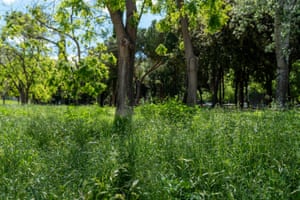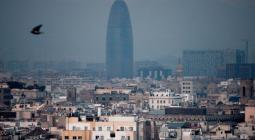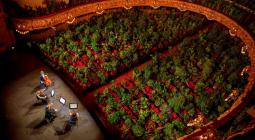Bat boxes, 'greened' streets and bug hotels: Barcelona embraces its wild side.

The spring lockdown brought butterflies and biodiversity to the Spanish city, and inspired a reimagining of its relationship with nature
When Barcelona’s inhabitants emerged from a six-week lockdown at the end of April last year, they found that while the city had lain dormant, nature had been busy transforming the streets and parks into a bucolic wilderness.
“The parks were shut, so there was no pressure on them from humans or dogs and no gardening was carried out,” says Margarita Parés, who heads the city’s biodiversity programme.
“It was spring and it rained a lot more than usual. The result was an explosion in plant growth, so there were more insects and more food for birds. And there were many more butterflies, as they are a species that reacts very quickly to changes in the environment.”
The Urban Butterfly Monitoring Scheme found that in May and June there were 28% more species per park and 74% more butterflies than the same period in 2019, including new species not previously seen in the city such as the rock grayling (Hipparchia semele) and lesser purple emperor (Apatura ilia).
Once the gardeners went back to work, the question was whether to return everything to its neat and tidy state, or let nature take its course?
The answer is neither. Parés says the council spent the previous two years working on plans to “naturalise” or rewild the city – and was about to announce this change of policy when the pandemic struck. By the time the lockdown ended, it was a lot easier to sell rewilding to a public craving fresh air and open spaces.
The city is now in the process of creating 783,300 sq metres of green open space, including an area around the landmark Sagrada Familía basilica, and 49,000 sq metres of “greened” streets.

The city is also encouraging bird and insect life with around 200 nesting towers for birds and bats, 40 beehives and around 80 plantings designed specifically as insect “hotels”. The council has also published a biodiversity atlas listing all the city’s flora and fauna.
When it comes to embracing nature in its cities, Spain lags behind many countries. But it is hoped that Barcelona’s new policy will go some way to rectifying that.

“In a city like Barcelona, it’s a case of replacing what exists with green infrastructure,” says Lorena Escuer, who runs Hydrobiology, a natural pest control company, and has worked in Barcelona on a pilot scheme called Alcorques Vivos, which plants wildflowers at the base of trees in the streets rather than surrounding them with pavement or grating.
“It’s not just having a park surrounded by asphalt but introducing nature into the city,” she says. “People need re-educating. Their idea of a clean space is somewhere where there’s no life, where the ecosystem is dead. There’s this idea that nature is something outside and that what’s natural for the city is for there to be nothing.”
Francisco Bergua, president of the Spanish Association of Parks and Public Gardens (AEPJP), says it is important for people to see that rewilding is not just a policy of negligence. “No one looks at a flower growing in a stone wall in the mountains as something ugly but the same flower growing in a city wall is seen as a sign of neglect,” he says.
Barcelona is unusual among Spanish cities in that it has its own parks department whereas most local authorities contract work out. As a result, in most urban areas the work is seen essentially as cleaning and maintenance rather than nature conservation.
“Some people believe that rewilding is an excuse for local authorities not to carry out maintenance and cut jobs, but they’re mistaken,” says Escuer. “These spaces need to be managed but not in the traditional way, which means gardeners have to be re-educated too.”
“Naturalising the city isn’t the same as making it a wild space,” says Bergua. “But instead of parks and gardens we need to think in terms of green infrastructure. Doing the same thing in a different way.”
Parés says the new approach to gardening should be understood in the context of the city’s commitment to conserving biodiversity with a policy that saves water, energy, material and money, and is more sustainable.
She adds that there are plans to dig up areas of asphalt in order to make the city greener, but in a city as dense as Barcelona the other option is to go up.
Architect Sergio Carratalá and his MataAlta Studio have created a roof garden on an unusually large 19th-century block situated near the old port. Carratalá, who sees rewilding as a form of deconstructing the built environment, has planted the roof with 10,000 native perennials that are pollinator friendly and drought resistant, to provide flowers all year round as well as feeding and nesting places for birds.
Rainwater is collected in tanks and the garden is irrigated with pumps driven by solar panels on the roof. When the scheme is complete, it will provide a vibrant slice of nature for the building’s more than 200 residents.
Carratalá says Covid has forced us to look at nature in a different way. “It’s made us look at how we live and how we want to live,” he says. “There’s no going back from here.”
Bergua agrees. “The lockdown gave us a glimpse of nature in the city and we liked it.”
Find more age of extinction coverage here, and follow biodiversity reporters Phoebe Weston and Patrick Greenfield on Twitter for all the latest news and features
31 January 2021




